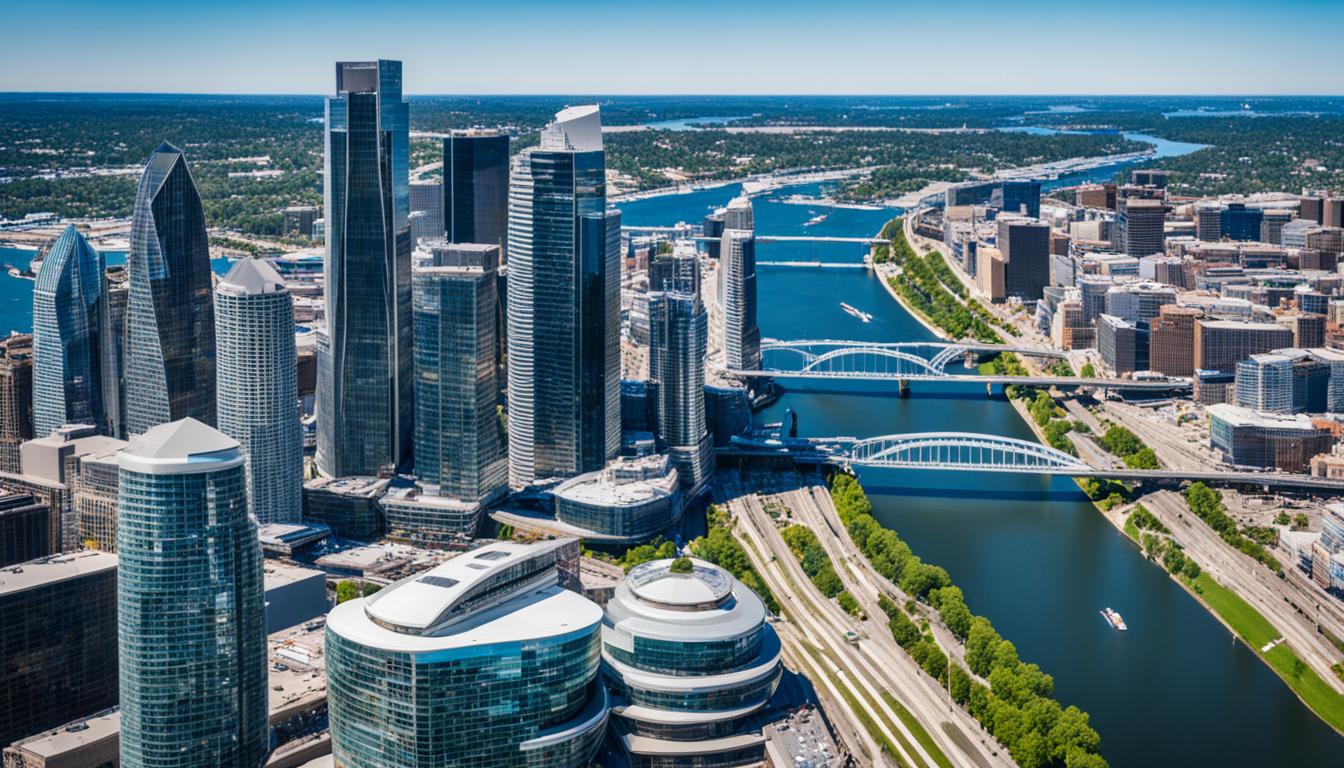Thinking about jumping into commercial real estate investment? You’re in good company. This market is booming, attracting investors looking for big returns. But, getting started can seem daunting. Don’t worry, we’ve got you covered. This guide will walk you through the basics of commercial real estate investment. You’ll learn how to make smart choices and grow your portfolio.
Key Takeaways
- Understand the different types of commercial properties and their unique characteristics
- Learn how to evaluate investment opportunities through property valuation and due diligence
- Discover effective investment strategies, such as buy-and-hold and fix-and-flip
- Explore financing options and manage risks associated with commercial real estate
- Gain insights into the art of maximizing returns and minimizing potential pitfalls
Understanding Commercial Real Estate Investment
Commercial real estate covers a wide range of properties, each with its own features and investment needs. It’s key for investors to know the different types of commercial properties and their return potential.
What is Commercial Real Estate?
Commercial real estate is for business use, not homes. It includes office buildings, retail spaces, industrial facilities, and more. These properties are valued by how much money they can make, making them a good choice for investors looking for steady returns.
Types of Commercial Properties
Investors can look at several types of commercial properties:
- Office Buildings – These are for work, from small buildings to big skyscrapers.
- Retail Spaces – This includes malls, strip centers, and single stores for customers.
- Industrial Facilities – These are for making things, storing goods, or other production tasks, needing special setups.
- Multifamily Housing – These are places like apartments or condos managed for rental income.
Each type of property has its own set of things to consider, like who the tenants are and what kind of setup is needed. Knowing these details is important for investors to make smart choices in commercial real estate.
“The key to successful commercial real estate investing is to focus on properties that can provide a stable and reliable stream of rental income.”
Evaluating Investment Opportunities
Investing in commercial real estate requires a careful look at each opportunity. This part talks about how to value properties and why doing your homework is key. It helps you understand the risks and rewards of a commercial property.
Property Valuation Methods
Finding out a property’s true value is the first step in seeing if it’s a good investment. Experts use three main ways to value commercial properties:
- Income Approach: This method looks at how much money a property can make. It considers things like rent rates, how full the property is, and costs to run it.
- Sales Comparison Approach: This method checks out what similar properties sell for nearby. It helps figure out the market value of the property you’re looking at.
- Cost Approach: This method works out the cost to build the property again. It takes into account the land’s value and how much the buildings are worth less because they’re old.
Conducting Due Diligence
After figuring out a property’s value, it’s time to do your homework. This means looking closely at different parts of the property, such as:
- How the property looks and any fixes it might need
- Who rents it and the terms of their leases, how much rent they pay, and how full it is
- Rules about what you can do with the land and the property
- Any risks like harmful materials or environmental issues
- Financial details like income and expenses, and any loans or debts
Using these methods to value properties and doing your homework helps investors make smart choices. It helps them find the best investment opportunities in commercial real estate.

Guide to Commercial Real Estate Investment
Entering the world of commercial real estate investment can be both challenging and rewarding. This guide aims to give you the key knowledge and tools for making smart choices. It’s perfect for both new and experienced investors.
First, it’s important to understand the commercial real estate market in your area. Look at population growth, job opportunities, and infrastructure plans. This will help you spot good investment spots and avoid risks.
Then, you should evaluate potential investment properties. Think about the property’s condition, who the tenants are, and how much money it makes. Use methods like the capitalization rate and discounted cash flow to figure out a property’s real value. Always do your homework to find any hidden problems or issues.

After finding a good property, look at your financing options. Check out traditional bank loans, commercial mortgages, and other options like private equity or crowdfunding. Knowing the good and bad of each choice will help you pick the best financing for your investment.
Finally, develop an investment strategy that fits your financial goals and how much risk you can take. Think about whether you want to hold onto a property or flip it. Also, spreading your investments across different types of properties and locations can reduce risk and improve your returns.
This guide will prepare you to handle the complex world of commercial real estate. With the right knowledge, you can make choices that lead to success over time.
Investment Strategies for Commercial Properties
Commercial real estate investments can be complex, but knowing the main strategies helps you make better choices. Two main methods are the buy and hold and fix and flip strategies. Each has its own pros and cons.
Buy and Hold
The buy and hold strategy means buying a commercial property to keep it for a long time. This could be years or even decades. The goal is to earn steady rental income and see the property’s value grow.
Investors like this strategy for its consistent income, equity growth, and tax benefits. But, it needs a big upfront investment and can be affected by market changes.
Fix and Flip
The fix and flip strategy is different. It involves buying a property, fixing it up, and then selling it for a profit. This method is popular with investors looking for quick gains and who know a lot about fixing up properties.
This strategy has fast returns, control over property value, and the chance for more deals. But, it also has risks like unexpected renovation costs and market changes.
When picking an investment strategy, think about your financial goals, how much risk you can handle, and how long you plan to invest. Knowing the details of buy and hold and fix and flip can help you pick a strategy that fits your goals.
“Successful commercial real estate investing is all about finding the right balance between risk and reward.”
Financing Options for Commercial Real Estate
Investing in commercial real estate requires the right financing options. Savvy investors know it’s key to look at different financing options. This helps them get the resources they need to make their real estate dreams come true.
Traditional financing often comes from banks or other lenders. They offer loans like commercial mortgages, bridge loans, and construction loans. Each type is designed for different investment needs.
But there are also other ways to finance, like private equity funds, crowdfunding, and REITs. These financing options can give investors the money they need. They often have flexible terms and easier approval processes.
When looking at financing options, consider things like interest rates, loan terms, and down payment needs. Think about the total cost of borrowing too. This helps investors make choices that fit their goals and how much risk they can take.
Understanding the different financing options is key to successful commercial real estate investing. By looking at all the possibilities, investors can find the best fit for their projects or properties. This can lead to great opportunities and higher returns.
Managing Risks in Commercial Real Estate Investing
Investing in commercial real estate can be profitable but comes with risks. To handle these risks, it’s important to diversify and plan your exit strategies well.
Diversification
Diversifying your investments is key to managing risk. By putting money into different types of properties and locations, you spread out your risk. This way, if one investment doesn’t do well, it won’t affect the others as much.
Exit Strategies
Having a solid exit strategy is vital for risk management in commercial real estate. It means knowing when to sell a property, like when you’ve made a good profit or the market changes. A clear plan helps you make the most of your investments and reduce risks.
To succeed in commercial real estate investing, you need a plan that includes diversification and exit strategies. These strategies help you deal with the market’s ups and downs. They increase your chances of making a profit in the long run.
“The key to managing risk in commercial real estate investing is to maintain a well-diversified portfolio and have a clear plan for exiting investments when the time is right.”
Conclusion
This guide to commercial real estate investment wraps up with a key message. It’s all about doing your homework, being careful, and planning well before diving into this exciting market. The guide to commercial real estate investment has shared important tips and strategies. These can help you make smart choices and succeed in the commercial real estate world.
Are you looking to grow your wealth over time, make quick profits, or a mix of both? This guide has given you the tools and knowledge to spot, check out, and make the most of good commercial real estate deals. You now know about different property types, how to value them, financing options, and ways to manage risks. This info helps you craft an investment plan that fits your goals and how much risk you can take.
Keep being careful, flexible, and eager to learn as you move forward in commercial real estate. The market changes all the time. Keeping up with trends, market conditions, and new chances is key to doing well. By using what you’ve learned from this guide, you can make the most of commercial real estate. This can help you build a portfolio that gives you steady, long-term gains.
FAQ
What is commercial real estate?
Commercial real estate includes properties for business use, like office buildings and retail spaces. It also covers industrial facilities and multifamily housing. These properties are bought and managed for making money, not for living.
What are the different types of commercial properties?
Commercial properties include offices, retail spots like shops and restaurants, and industrial sites like warehouses. There are also multifamily homes like apartments and condos.
How do I evaluate a commercial real estate investment opportunity?
To check out a commercial property, look at its value using different methods. This includes the income, sales comparison, and cost approaches. Make sure to dig deep into the property’s finances and market trends to spot risks.
What are the common investment strategies for commercial real estate?
Investors often use the “buy and hold” strategy, keeping a property for income. Or, they might go for the “fix and flip” method, buying, improving, and selling for profit.
What financing options are available for commercial real estate investments?
Investors have many financing choices, like bank loans, commercial mortgages, private equity, and crowdfunding. The right option depends on your goals, the property, and the terms available.
How can I manage the risks in commercial real estate investing?
To handle risks, spread out your investments, plan your exits, and keep up with market trends. Good risk management can lower losses and boost your returns.
